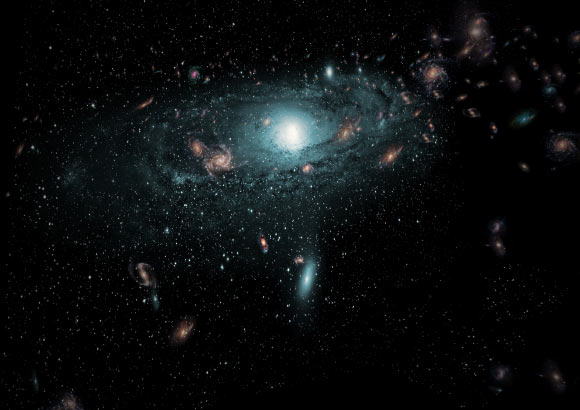Almost 900 hidden nearby galaxies have been studied by an international team of astronomers, shedding new light on the Great Attractor — a diffuse concentration of mass 250 million light-years away, that’s pulling our Milky Way Galaxy, and thousands of other galaxies towards it.
Using the multibeam receiver on CSIRO’s 64-m Parkes radio telescope, the team was able to see through the stars and dust of our Galaxy, into a previously unexplored region of space known to astronomers as the ‘Zone of Avoidance.’
“We found 883 galaxies, a third of which had never been seen before,” said team member Prof. Lister Staveley-Smith, from the ARC Centre of Excellence for All-sky Astrophysics and the University of Western Australia node of the International Centre for Radio Astronomy Research.
“The Milky Way is very beautiful of course and it’s very interesting to study our own Galaxy but it completely blocks out the view of the more distant galaxies behind it.”
Prof. Staveley-Smith, who is the lead author of a paper published online today in the Astronomical Journal, said: “scientists have been trying to get to the bottom of the mysterious Great Attractor since major deviations from universal expansion were first discovered in the 1970s and 1980s.”
“We don’t actually understand what’s causing this gravitational acceleration on the Milky Way or where it’s coming from.”
“We know that in this region there are a few very large collections of galaxies we call clusters or superclusters, and our whole Milky Way is moving towards them at more than 2 million km per hour.”
Prof. Staveley-Smith and his colleagues also identified several new structures that could help to explain the movement of our Galaxy, including three galaxy concentrations and two new clusters.
“Three new galaxy concentrations (named NW1, NW2 and NW3) are key in confirming the diagonal crossing of the Great Attractor Wall between the Norma cluster and the CIZA J1324.7-5736 cluster,” they said.
“Further contributors to the general mass overdensity in that area are two new clusters (named CW1 and CW2) in the nearer Centaurus Wall, one of which forms part of the striking 180 degrees long filament that dominates the southern sky at velocities of 3,000 km/s, and the suggestion of a further Wall at the Great Attractor distance at slightly higher longitudes.”
Prof. Renée Kraan-Korteweg, an astronomer at the University of Cape Town in South Africa and a co-author on the study, said: “astronomers have been trying to map the galaxy distribution hidden behind the Milky Way for decades.”
“We’ve used a range of techniques but only radio observations have really succeeded in allowing us to see through the thickest foreground layer of dust and stars.”
“An average galaxy contains 100 billion stars, so finding hundreds of new galaxies hidden behind the Milky Way points to a lot of mass we didn’t know about until now.”
_____
L. Staveley-Smith et al. 2016. The Parkes HI Zone of Avoidance Survey. Astronomical Journal 151, 52; doi: 10.3847/0004-6256/151/3/52








